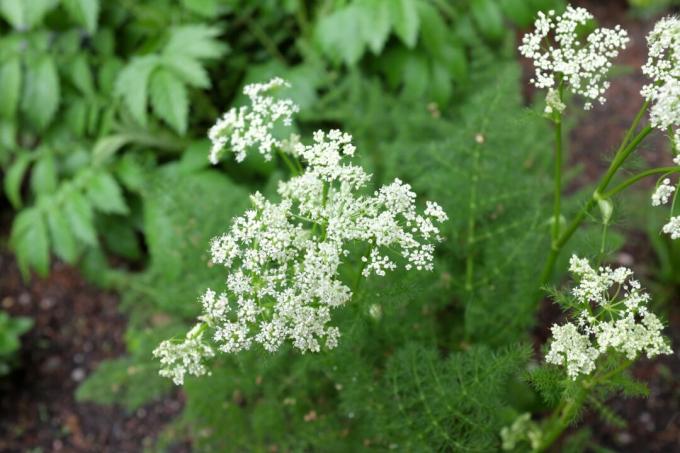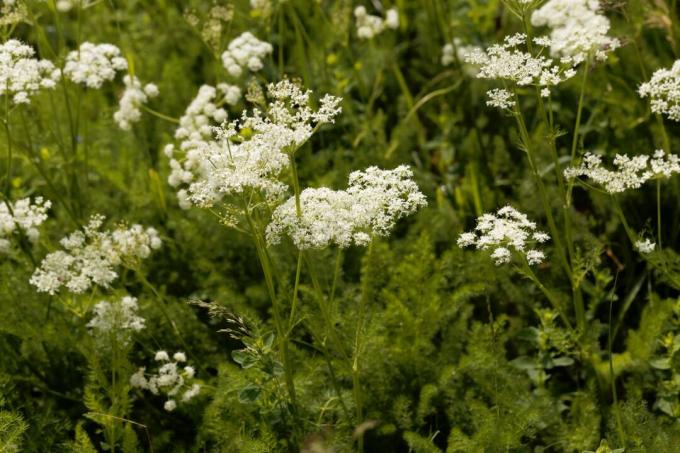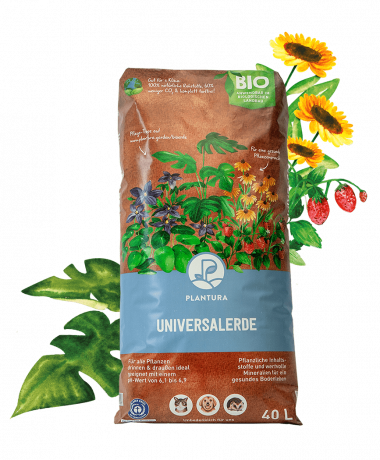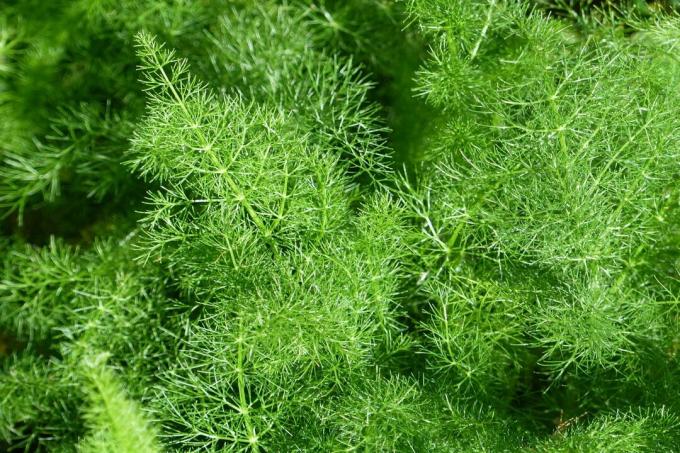Bärwurz not only convinces with the pretty umbels of flowers and the delicate, almost cloud-like leaves, but is also used in the kitchen.

The almost forgotten culinary herb tastes delicious, is versatile and also very easy to care for. Bärwurz (Meum athamanticum) is even suitable for garden beginners - we will show you here in which location Bärwurz feels most comfortable and with which relatives it is often confused.
Contents
- Recognize Bärwurz: Properties and origin
- Confused with Bärwurz: Similar plants
- Plant Bärwurz: location and procedure
- The right care
- Harvest, use and effect of Bärwurz
Recognize Bärwurz: Properties and origin
The natural habitat of Bärwurz is in the montane to subalpine regions of the European mountains up to 1000 m above sea level. In Germany one discovers Meum athamanticum often in the Harz, Fichtel and Erz Mountains, in the Eifel and in the Black Forest. Bärwurz is a rarity in the Bavarian Alps.
Meum athamanticum belongs to the umbelliferae family (Apiaceae) and is currently the only recognized species within the genus meum. The umbrella-shaped inflorescences, which are referred to as double umbels, are typical of this plant family. Several individual flowers are stalked and emanate from a point on the flower stalk, which in turn meet at a point on the leaf axil. Meum athamanticum shows its single flowers in white, pale yellow to pink color from May to June and reaches a total height of between 20 and 40 cm. The deciduous Bärwurz herb is easy to recognize by the angular, serrated stem and the multi-pinnate leaves, which at first glance are reminiscent of fennel leaves. If you rub the leaves, you can look forward to an anise-like, spicy scent.
The umbellifer also forms a strong rhizome, which can reach up to 1 m deep. For this reason, the Bärwurz is not suitable for planting in a pot. Due to the easily accessible flowers and the nectar and pollen supply, insects such as bees and bumblebees also enjoy the pleasantly fragrant herb. is pollinated Meum athamanticum often by beetles and flies. The Bärwurz fruits are ripe from July. They appear in a furrowed form and are brownish in colour. Since these are two-seeded closed fruits, they are referred to as double achenes or split fruits.
By the way: The origin of the name has not been agreed since the Middle Ages. For some it came from the Gebearmother, since Bärwurz is used in folk medicine to treat menstrual cramps. Others suspect that there is a connection with the real bear and its fur. Bärwurz is also known as bear fennel, dill leafroot or motherwort.
Confused with Bärwurz: Similar plants
Bärwurz is often confused with relatives from the umbelliferae family. For example, the inflorescence of Caraway seeds (Carum carvi) look very similar, although on closer inspection you will notice differences in the leaves. fennel (Foeniculum vulgare) and dill (Anethum graveolens), on the other hand, have similar foliage but show yellow individual flowers. The aromatic scent of Bärwurz can be clearly identified after crushing the leaves. Because of the German name, Bärwurz is often mentioned Bloodroot (Potentilla erecta) confused, where potentilla belongs to the rose family (Rosaceae) and differs significantly in appearance.

Plant Bärwurz: location and procedure
In its natural location, Bärwurz grows in sunny to partially shaded locations on fresh and rather poor soil. These are also more acidic to neutral. With slightly nutrient-rich soil, it develops a higher vigour. More important, however, is the structure - this should be permeable, since waterlogging of Meum athamanticum is not tolerated. Select perennial nurseries also offer Bärwurz pre-cultivated, Bärwurz seeds are more common on the market.
Once the right location has been found, you can start sowing. Prepare the bed soil by removing weeds if necessary and installing a drainage layer of gravel or grit in waterlogged soil. In order to obtain an optimal soil structure, we recommend improving soil that is too heavy or too light with a suitable substrate. A small amount of compost will provide the nutrients plants need, but be careful - compost can increase pH. Our Plantura organic universal soil has a pH value of 6.1 to 6.9 and is therefore ideal for bear's root herb. In addition, it does not require peat and is therefore more environmentally friendly.

Organic universal soil 40 L
- Ideal for all plants in the house, garden and on the balcony
- Ensures a vital & strong plant splendor as well as a healthy soil life
- Peat-free & climate-friendly: CO2-reduced organic soil made in Germany
Bärwurz is a so-called cold germ, which means it needs a certain cold period to germinate. Before this cold period, humid and warm conditions at an ideal 15 to 20 °C should prevail for 3 to 4 weeks. Therefore, sowing outdoors in late summer to autumn is recommended. Alternatively, the seeds can be grown in a seed tray from January to March at the temperatures mentioned and further cultivated for about 6 to 8 weeks, for example in the refrigerator, at temperatures of 5 °C become. In both cases, pay attention to a sowing depth of 1 cm and a seed spacing of about 25 to 30 cm outdoors. In the seed tray, this distance can be around 4 cm - if the first real leaves can be seen, the plantlets should be pricked out. Finally, the seeds are watered and kept moist at all times. The seedlings in the refrigerator should be well ventilated to avoid mold growth.
Tip: Total stands Meum athamanticum preferably in smaller groups of 3 to 10 plants. Bärwurz can also be wonderfully combined with plant neighbors in its natural habitat. These are, for example, the Alpine lady's mantle (Alchemilla alpina), True Ziest (Stachys officinalis) and arnica (Arnica montana).

The right care
Once Bärwurz has established itself, it is very easy to care for and does not need to be fertilized. A substrate that is too poor can be improved with a small amount of compost in the spring before growth begins. The herbaceous plant is used to fresh soil, so it should be watered during long dry periods. A pruning in itself is not necessary. However, if you want a compact growth form, it is advisable to cut the perennial back regularly. The perennial is very tolerant of pruning and will sprout again without any problems. Another cut is recommended to remove the dead leaves from the previous year in the spring before the new shoots. If you want to prevent the Bärwurz from spreading unintentionally, you should cut back the inflorescences before the seeds ripen, as they like to seed in the garden and easily. Temperatures down to -23 °C can be withstood without hesitation, which is why overwintering can take place outdoors without additional measures.

Harvest, use and effect of Bärwurz
The umbellifer does beautifully in mixed beds, on rocky slopes or rockeries. It impresses with its delicate leaves and beautiful umbels of flowers, but also allows other perennials to take their place.
Bärwurz can often be found in monastery and kitchen gardens. This is mainly due to the possible use in the kitchen, since all parts of the plant are edible. Bärwurz has an anise-like taste. For example, the leaves can be combined with other herbs to make a delicious cream cheese. The dried split fruits are ideal as a spice, for example for soups. In the Bavarian Forest, the herb is best known for the Bärwurz schnapps, which is very easy to prepare. To do this, the freshly harvested root is washed and crushed, generously poured with corn schnapps and left to stand for 6 weeks - done!

Bärwurz leaves can be harvested all year round, although young, freshly grown foliage before flowering is more aromatic. Choose a day that is as dry as possible. Herbs are ideally dried in a shady and cool, but airy place. The brown seeds can be harvested from July to August when the fruit is ripe. The roots are dug up, cleaned and processed in autumn after the fruit has ripened.
Folk medicine ascribes good properties to Bärwurz, for example in the case of stomach cramps, flatulence and other digestive problems as well as bladder diseases or kidney problems. So far, however, no healing effects have been proven, which is why Bärwurz is not found in conventional medicine.
Another representative of the umbelliferae is the angelica (Angelica), which is not only a pretty addition to the garden, but can also be used in the kitchen.
Register now for the Garten-Post and receive great tips, seasonal trends and inspiration on everything to do with the garden from our expert every week.



